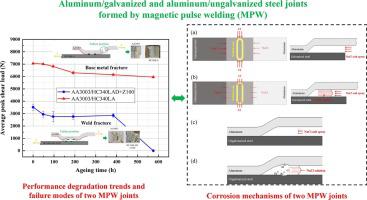Journal of Manufacturing Processes ( IF 6.1 ) Pub Date : 2021-02-26 , DOI: 10.1016/j.jmapro.2021.02.039 Shaoluo Wang , Kang Luo , Tao Sun , Guangyao Li , Junjia Cui

|
Dissimilar material welded joints will inevitably suffer atmospheric corrosion during service, which may lead to premature failure of the dissimilar welded joints. Hence, in present study, corrosion behavior and mechanism of aluminum/galvanized steel and aluminum/ungalvanized steel magnetic pulse welding (MPW) joints were compared and discussed systematically. Neutral salt spray (NSS) tests, electrochemical tests, and microscopic observations were conducted. Results manifested that mechanical performance of the two MPW joints decreased with increasing ageing time, but the mechanical property decline law was different. Degradation degree of mechanical property of aluminum/non-galvanized steel joints was significantly lower than that of aluminum/galvanized steel joints, and the strength of the former was more than twice that of the latter. Corrosion mechanisms of two MPW joints were revealed by analyzing morphologies and corrosion products of the joints. Aluminum/galvanized steel joints were destroyed due to the corrosion of welded area by NaCl salt spray from arc-shaped weld area. However, galvanic cell was formed in the lap area of aluminum/ungalvanized steel joint, and galvanic corrosion occurred; it mainly caused aluminum sheet to be damaged, thus reducing its mechanical performance. Total electrochemical corrosion resistance of aluminum/galvanized steel MPW joints was stronger than that of aluminum/non-galvanized steel joints. Difference in corrosion property between the two MPW joints was mainly owing to the existence of zinc layer. Presence of zinc layer could descend the total electrochemical corrosion rate of aluminum/steel joints, but it also reduced the strength of the joints. This resulted in different corrosion types, thereby causing different failure modes and fracture mechanisms.
中文翻译:

镀锌钢板与铝合金薄板电磁脉冲焊接接头的腐蚀行为及失效机理
异种材料的焊接接头在使用过程中不可避免地会遭受大气腐蚀,这可能会导致异种焊接接头的过早失效。因此,在本研究中,系统地比较和讨论了铝/镀锌钢和铝/非镀锌钢磁脉冲焊接(MPW)接头的腐蚀行为和机理。进行了中性盐雾(NSS)测试,电化学测试和显微镜观察。结果表明,两个MPW接头的力学性能均随着时效时间的增加而降低,但力学性能的下降规律却有所不同。铝/非镀锌钢接头的机械性能退化程度明显低于铝/镀锌钢接头,并且前者的强度是后者的两倍以上。通过分析接头的形貌和腐蚀产物,揭示了两个MPW接头的腐蚀机理。铝/镀锌钢接头由于弧形焊接区域的NaCl盐雾腐蚀而腐蚀了焊接区域。但是,在铝/镀锌钢接头的搭接部位形成了原电池,发生了电腐蚀。这主要是造成铝板损坏,从而降低其机械性能。铝/镀锌钢MPW接头的总电化学耐腐蚀性强于铝/非镀锌钢接头。两个MPW接头之间的腐蚀性能差异主要是由于存在锌层。锌层的存在会降低铝/钢接头的总电化学腐蚀速率,但这也降低了关节的强度。这导致了不同的腐蚀类型,从而导致了不同的失效模式和断裂机理。











































 京公网安备 11010802027423号
京公网安备 11010802027423号